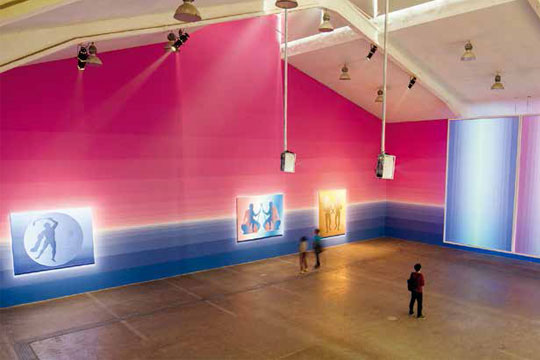XU QU: A HIT
| May 23, 2014 | Post In LEAP 26

Tang Contemporary Art Center, Beijing
How do you pull off a solo exhibition with painting as its core in a 400-square-meter gallery with a ceiling that reaches 12 meters high at its peak? This space has previously hosted massive, visually aggressive, and spatially oppressive installations, such as Sun Yuan and Peng Yu’s contemporary spectacle Freedom, macro-narrative fabrications like Huang Yong Ping’s Leviathanation and Shen Yuan’s Sky Ladder, and Wang Du’s International Kebab, which was built with a nine-meter scaffold and seven tons of photographs. A gallery, like a theater, can be pigeonholed by the tremendous performances that have there been enacted; whoever follows next must come up with something novel.
Xu Qu, an artist who has recently focused his energies on painting, has rewritten the handbook on how to use Tang Contemporary’s cavernous space. He does so with an integrated vision that covers the gallery’s walls, composed of massive, dynamic projections; an installation and sculpture series that explore the relationships of positive and negative space; and a series of paintings that sustains the thematic core of the exhibition. In order to realize this conceptually minimal exhibition, Xu eliminated unnecessary elements. What is left is a phantasmal red-blue color scheme, consummate contouring derived from ancient Greek art, and lines of color that produce a sense of industrial three-dimensionality on the picture planes of his paintings, meticulously outlined and laid out according to modern feng shui.
Yet there is nothing new about Xu’s overall structuring of the exhibition. In a certain sense, the fundamental difference between a solo exhibition and a group show can be described as the contrast between an artist’s exhibition and a curator’s exhibition. When it comes to achieving strength of visual suggestion and conceptual communication, formulating an organic structure in concert with the space is more effective than bringing individual, unrelated works from the studio to the gallery. This exhibition serves as testimony that Xu Qu, since concluding his studies in Germany in 2010 and formally embarking on his career in Beijing, has spent the past four years accumulating experience in analyzing patterns and controlling space.
“A Hit” is an artist’s exhibition in the fullest sense: no curator, no textualized concept. The gallery and the studio are treated as coordinated parts of an integrated project. This sort of exhibition has become a mainstream trend in which the artist is his or her own curator and must control every detail of the workflow, exhibition structure, and visual presentation. Artist control of the production aspect has been the optimal model for exhibitions ever since Andy Warhol established the tradition of big studios more than half a century ago. Today, new approaches to this model are continually emerging. A growing group of artists have actively or passively become managers and renaissance men, leading to an increase in the overall professionalism of the field. One might protest that this increased professionalism is just one of many directions taken by Chinese contemporary art practitioners over the past decade. Regardless, it has already become a fundamental element of the dichotomy between the individual and the art industrial complex, at present and for the foreseeable future.
It is the audience who retains the most passive role, for the audience has not substantively been incorporated into the art ecosystem. Indeed, the act of viewing has been co-opted by the artist’s absolute control of the exhibition. There is little room left for debate; that which remains to be observed is a visual phenomenon that approaches perfection. But when the spectator pauses and averts his or her eyes, he or she realizes that this exhibition is but a moment frozen in time, and no more; when heading back into reality, no realizations have been made.

